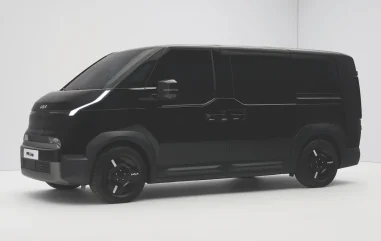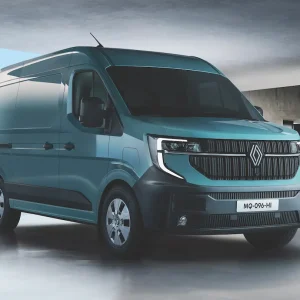
A little over a year since it first revealed the concepts at the Consumer Electronics Show in January 2024, Kia has officially unveiled its new PV5 van, the first in a series of electric vans it will launch this year.
Unveiled in February at Kia’s EV Day near Barcelona alongside the new Kia EV4 and a Kia EV2 concept, the Kia PV5 van and Kia PV5 people mover are the first in the Korean manufacturer’s line-up of Platform Beyond Vehicle (PBV) models.
They will be built on Kia’s E-GMP.S platform – an adapted version of its E-GMP dedicated battery-electric skateboard architecture. The additional ‘S’ in the title
is said to stand for ‘Service’, representing the service vehicles that will be built on the platform, on which Kia plans to include multiple models and differing body types.
An electric skateboard platform uses standardised components like batteries and motors to improve the production process, streamline efficiency and reduce costs, while sitting on top of the platform will be Kia’s Flexible Body System. The modular body assembly, Kia says, will allow it to address the diverse needs of customers, several of whom are already committing to purchasing the van.
As well as the panel van, Kia plans to build passenger version, chassis-cab and WAV (Wheelchair Accessible Vehicle) models. There will also be conversions
with the crew (for Europe only) dropside, box van, freezer box, Prime (based on
the people mover), and light camper van models.
The body will come in two lengths with a standard wheelbase and a long version that gets a 200mm extended rear overhang. There’s also a high-roof option that will be available with a walk-through bulkhead making it suitable for the home delivery and courier markets.
Kia has worked hard to minimise the entry height, creating a step height of just 419mm. This has been achieved by lowering the rear loadspace floor to its lowest level. In doing so it has created a narrower than usual loadspace between the wheelarches. The 900mm gap is, however, large enough for a Euro pallet to be loaded vertically, and with a wide side access door, a second Euro pallet can be loaded horizontally through the side opening. Overall load volumes will range from 3.4m3 to 5.1m3.
The rear also gets an optional L-track mounting system, similar to those used in cargo airlines, to safely secure goods in any position within the PV5 cargo area. The vans can have two rows on each side of the loadspace with two rows along the headlining and one row on the partition wall in the walk-through variant).
“By integrating the clean efficiency of an electric powertrain with the unprecedented flexibility of our new PBV architecture and advancing our product, software, and manufacturing innovations, the PV5 embodies our core values as a sustainable mobility solutions provider,” said Ho Sung Song, Kia president and CEO.
“Modern vehicles have become incredibly complex, but with the PV5, Kia has united multiple cutting-edge technologies toward the goal of simplifying users’ mobility experiences. This removes complexity from their personal transport needs and frees them to focus on the pursuit of their ambitions and fulfilment of their passions.”
The Kia PV5 Cargo stays true to the size of the concept with a length of 4,500mm, a width of 1,900mm and a height of 1,900mm. The wheelbase length is 3,000mm and its overall size makes it closely matched to VW’s ID Buzz.
Power comes from a front-mounted electric motor, producing up to 120kW and 250Nm of torque paired to either a 51.5kWh or 71.2kWh battery, however, there’s also a 43.3kWh option for the PV5 Cargo. However, while this is available on launch models, it’s unlikely to be available in the UK and may remain as a specific fleet-only option.

The largest battery option passenger van has a claimed range of 249 miles, but official testing has yet to finalise those numbers. The PV5 will get fast-charging speeds of up to 350kW which will see a recharge from 10% to 80% in less than 30 minutes.
The cabin gets a two-seat layout as standard, with a three-seat option. There’s also a 7in instrument cluster and a 12.9in navigation screen, which uses an Android Automotive OS-based infotainment system. This will allow business-specific applications to be used, as well as providing over-the-air (OTA) updates to the vehicle.
Systems will also allow a huge amount of proactive data to be gathered to enable predictive maintenance, keeping vehicles on the road and reducing repair time
and costs.
Kia also announced a partnership to integrate Samsung’s ‘SmartThings Pro’ internet-of-things (IoT) platform into the PBV range. This will help give businesses enhanced wireless control over connected devices through its plug-and-play system. Businesses could potentially manage IoT-enabled appliances without complex installations, connecting vans to other business environments. Kia cited the example of a small bakery owner who could pre-programme their vehicle to adjust its refrigeration system during ingredient pickups and then activate features like air conditioning and lighting upon their return to the premises.
Samsung’s SmartThings Pro will also use AI to suggest and refine automated business routines, which can be monitored and controlled through the vehicle’s system or a tablet. The initial focus will be on pilot services for small businesses and the self-employed.
Other functions for the vans include V2L (vehicle to load) functionality in the cargo area to supply power to tools and accessories.
“Every two years we are going to launch a new product; 2025, 2027 and 2029,” explained Sangdae Kim, head of PBV Division, Kia Corporation.
Since first revealing the PV5, Kia has been talking extensively to fleets, learning about the market and its requirements, and although a great deal of focus has been placed on the passenger version – you only need to look at the teaser images ahead of the reveal, which all focused on the passenger version – Kia sees a huge opportunity for the PV5 panel van. Despite the dominance of existing OEMs like Ford and Renault, as well as several new Chinese competitors, Kia is especially keen on cracking the market in Europe where it hopes to attract fleet, SME and owner-driver customers with its van range.
“We had some requests, and the market is changing; we are allowed to be bigger and a bit heavier. That requires some new versions,” explains Pierre-Martin Bos, director PBV, Kia Europe.
“I think it is important to see that there is this reaction, obviously it takes time to develop, but the E-GMP.S [platform] can hopefully adapt,” Bos adds.
Kia is backing the new venture with a massive investment of nearly £750m in a new manufacturing facility in South Korea. The dedicated PBV plant, known as the ‘EVO Plant’, will use a flexible production process, with both conveyor and cell-based systems, alongside a conversion centre for customised vehicle production.
More importantly, factory-built conversions will also be backed by the same seven-year warranty Kia will apply to the vans, when they go on sale later this year.
Kia gets van oven ready
Last year at the PBV range unveil in Las Vegas, I was more than sceptical about the chances of Kia producing a commercial vehicle that would be truly fit for purpose. All the talk of autonomous Ubers and pods that would fit seamlessly into the city environment made the whole concept of a practical, working van seem like a fairly low priority.
Thankfully, the product unveiled at Kia’s EV Day was far from impractical. There were a few raised eyebrows when it came to the ultra-narrow load floor, but once it was explained to me that an option for a solid floor above the wheelarch level would be possible, and that this version was purely to demonstrate the possibilities for the 1.8m headroom in the van the PV5 made a lot more sense. Kia is so late to the commercial vehicle party that they might bring their own broom to help them sweep up. But by playing to the margins with clever little design ideas, like that low entry height and high roof, they’re clearly looking at the specific needs of a select bunch of customers. Will it be enough to make the PV5 a success? Only time will tell. But I’m now a lot less sceptical than I was 12 months ago.
George Barrow is the UK judge for the International Van of the Year, the prestigious prize awarded by leading European LCV journalists.





